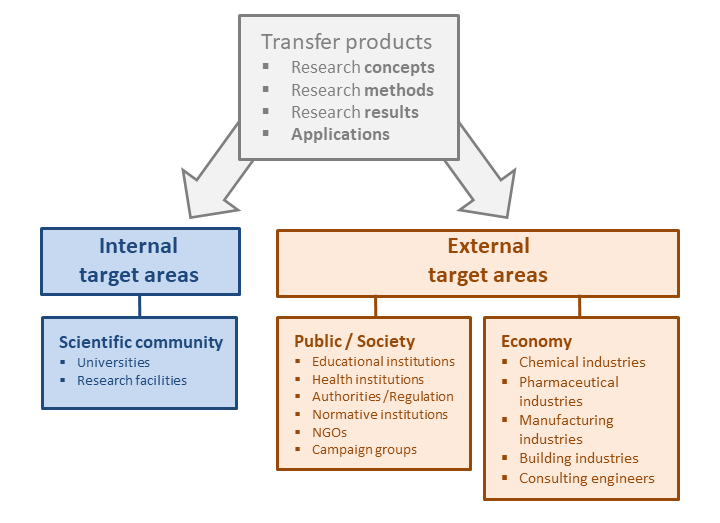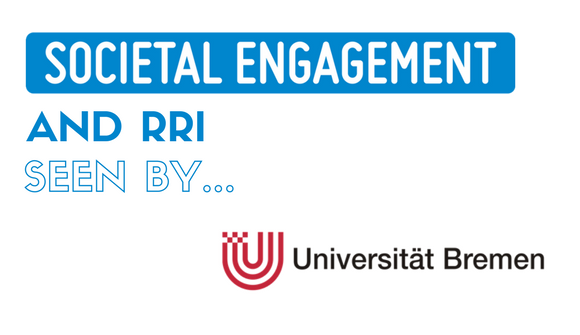
-
How do you understand Societal Engagement in biosciences research?
According to our understanding, Societal Engagement in biosciences research is the encouragement of all relevant societal actors for an engagement in the biosciences research and innovation process. The relationship between science and society and the communication between these groups has undergone a great change: from “science” and ‘”society” and the “deficit model of public understanding” (Gross, 1994: 6) to the idea of “science with and for society” and public participation.
Two crucial points for investigating as well as fostering interactions between scientists and citizens at the University of Bremen are the technology transfer and the communication of scientific knowledge through contextualization.
There are two different ways to transfer concepts, methods, results and applications. Science-internal technology transfer means transfer to the scientific community (as a part of society). Science-external technology transfer refers to transfer into economy and/or society. The diversity of transfer products and target areas requires a broadened concept of technology, since a theoretical concept may well be the starting point of an application development.

Diagram: Diversity of Technology Transfer in Biosciences
Research contextualization supports the communication process through emphasizing the particular societal relevance while obliging scientists to take into account ethical and political issues as well as issues of public interest/relevance.
-
What are the current standards and actions to achieve better Societal Engagement in the University of Bremen?
The relevance of technology transfer within the research institutes of the University of Bremen seems to be very heterogeneous, so far. This is due to the fact that both basic research as well as applied research is carried out within the university. According to the transfer strategy of the University marine sciences, neurosciences and environmental sciences (which are all located in the faculty 2 Biology/Chemistry) belong to the most important scientific areas for technology transfer. To foster technology transfer, eight central scientific units have been developed within the university in order to improve the practical relevance of their research. One of the central scientific units and a prime example for ongoing technology transfer and societal engagement is the Centre for Environmental Research and Sustainable Technology (UFT) where the interdisciplinary Graduate School NanoCompetence is located: Due to its interdisciplinary character (material scientists are working together with natural scientists) the UFT has much experiences in technology transfer. The Graduate School NanoCompetence is a good example for a place of exchange and cooperative knowledge development.
The University of Bremen organizes periodic events (e.g. Open Campus, Children’s Uni, Science Slams) to engage scientists and citizens in a dialogue and fosters interactions with the local and national press.
-
What are you aiming at with the implementation of the STARBIOS2 actions towards better Societal Engagement standards for the faculty Biology and Chemistry at the University of Bremen?
The planned actions on technology transfer focus on the evaluation of the effectiveness and the identification of best practice examples based upon a customized list of criteria. The list of criteria developed on contextualization leads to an application model for successful research contextualization, that may prepare scientists to present their work in public.
Corresponding activities are provided and aim at the engagement of different target groups, e.g. PhD students or young researchers. The activities are presented as building blocks to be combined with further activities regarding the other STARBIOS2 keys. With the implementation of the building blocks the awareness for and effectiveness of technology transfer and contextualization may be improved.
The overall objective is to contribute to the development of an RRI mission statement for the faculty 2 Biology and Chemistry.
-
What kinds of actions are you going to establish to fulfil these objectives?
On the basis of a comprehensive state-of-the-art analysis of former and current projects best practice examples of societal engagement and technology transfer in biosciences are identified. These best practice examples and criteria for successful outcome are arranged as a reflective reviewing guideline for scientists to reflect upon their research projects, topics or results in regards to societal engagement in the form of technology transfer and contextualization. Science students, PhD students as well as young researchers may benefit from the support on integrating SE as a steering element from the beginning of their research. Newly developed projects as well as the PhD theses in progress, created by these groups, will be consulted to evaluate the utilization attempts.
-
Who is involved in the action plan in order to complete the final objectives?
Science educators of the Institute of Science Education, Department Biology Education, work together with researchers of the Centre for Environmental Research and Technology, the Institutes of Ecology, Neurobiochemistry, Sustainable Chemistry, Molecular Biology as well as with social scientists of the Institute of Philosophy, and members of the faculty-intern quality control group.
The focus groups doctoral students, students and advanced researchers are important for the development, the evaluation and the implementation of the reflective activities. They also might be multiplicands to draw attention to societal engagement.
Read our previous article by the University of Bremen on Ethics in Biosciences Research.







